The Yacumama, a legendary creature said to inhabit the Amazon River, has captivated the imaginations of indigenous cultures and cryptid enthusiasts alike for generations. Described as a massive, serpent-like creature with the ability to swallow boats and cause tsunamis with a flick of its tail, the Yacumama is one of the most well-known legends of the Amazon. The name “Yacumama” translates to “Mother of the Water” in Quechua, a nod to the creature’s association with rivers and large bodies of water. However, like many mythical creatures, the Yacumama exists at the crossroads of folklore and skepticism. Is it a real, undiscovered species lurking in the murky waters of the Amazon, or is it simply a myth born from the dangers and mysteries of the jungle?
Evidence in Favor of the Yacumama’s Existence
Indigenous Testimony and Folklore
The strongest case for the Yacumama’s existence lies in the cultural history of the indigenous tribes of the Amazon. Tribes like the Shipibo-Conibo and the Quechua recount generations of encounters with this giant water serpent. Indigenous people describe the Yacumama as a guardian of the river, known to attack those who disrespect the water or hunt irresponsibly. For them, the Yacumama is not just a story but a fact of life that demands respect and caution when navigating the waterways.
These testimonies are often dismissed as folklore or metaphor, but it’s worth considering that indigenous cultures have survived in the Amazon for thousands of years. Their stories often serve as a form of ecological knowledge. For example, their depictions of jaguars, caimans, and anacondas are accurate and reflect real, dangerous animals. Could the Yacumama be a similar case, representing a creature not yet understood by modern science?
Reported Sightings and Eye-Witness Accounts
Throughout the 20th and 21st centuries, explorers and local fishermen have reported seeing unusually large serpentine creatures in the Amazon. Some claim to have seen what they believed to be the Yacumama itself—an animal reportedly between 30 to 50 meters long. For instance, in 1906, British explorer Percy Fawcett wrote about encountering a massive, snake-like creature in the Rio Abuna. He described the creature as longer than a boat and suggested that the jungle may harbor such hidden beasts.
Another report came from an expedition in the 1970s when witnesses claimed to have seen a giant creature moving through the waters of Lake Yarinacocha. These sightings, while anecdotal, fuel the belief that the Yacumama could be an undiscovered species.
The Anaconda Connection
One plausible explanation for the Yacumama’s existence is the green anaconda, the largest snake in the world, which inhabits the Amazon rainforest. Green anacondas can grow up to 9 meters (30 feet) long, with some unverified reports claiming they can reach lengths of 15 meters or more. While this falls short of the Yacumama’s reported size, exaggerated tales could easily stem from encounters with exceptionally large anacondas. Given the remote nature of the Amazon, it’s also possible that anacondas larger than those documented by science exist in more isolated regions.
Evidence Against the Yacumama’s Existence
Lack of Physical Evidence
Despite the numerous accounts of the Yacumama, no physical evidence has ever been found to support the creature’s existence. In the age of advanced technology, satellite imagery, and modern scientific exploration, no skeletons, remains, or clear photographic evidence of the Yacumama have surfaced. Unlike the Loch Ness Monster or Bigfoot, which have had hoaxes and misidentified creatures captured on film, there is no visual record that comes close to proving the Yacumama is real.
Skeptics argue that in a world increasingly monitored by drones and researchers, it would be almost impossible for a creature of such size to go undetected.
The Exaggeration of Indigenous Folklore
Many skeptics claim that the Yacumama is simply an exaggerated figure from indigenous folklore, possibly originating from real animals like the anaconda or caiman. Over time, as stories were passed down through generations, the creature may have taken on mythical proportions. The idea of a giant serpent swallowing boats and controlling the river could be seen as a cautionary tale, warning people to respect nature’s power.
Furthermore, many cultures throughout history have used animal imagery in their mythologies to explain natural phenomena or to symbolize the spiritual relationship between humans and the environment. The Yacumama could simply be an example of this tendency.
Alternative Explanations: Natural Phenomena
Some researchers propose that natural phenomena, rather than a cryptid, might be responsible for the Yacumama sightings. Sudden waves or whirlpools in the river could easily be misinterpreted as movements of a massive serpent. These phenomena can occur due to underwater currents, shifts in riverbeds, or the sudden movement of large animals like manatees, which also inhabit the Amazon and can create large disturbances in the water.
In addition, the Amazon’s dense, murky waters and thick vegetation make it easy for the human eye to misinterpret what it sees, especially in stressful or dangerous situations. An unusually large anaconda moving rapidly through the water could easily be mistaken for something far more enormous and terrifying.
The legend of the Yacumama continues to straddle the line between myth and reality. While indigenous testimony, eye-witness reports, and the presence of large serpentine creatures like the anaconda offer compelling evidence in favor of its existence, the lack of physical evidence and the tendency for folklore to exaggerate real animals challenge its validity. Whether the Yacumama is a cryptid waiting to be discovered or simply a cautionary tale of the Amazon’s untamed nature, it remains a powerful symbol of the mystery and danger that still pervades one of the world’s most impenetrable ecosystems.
Share Your Thoughts!
Do you think the Yacumama could be a real creature? Share your thoughts in the comments below!
